Mario Everaldo de Souza
Departmento de Física, Universidade Federal de Sergipe, São Cristovão, 49100-000, Brazil
Correspondence to: Mario Everaldo de Souza, Departmento de Física, Universidade Federal de Sergipe, São Cristovão, 49100-000, Brazil.
| Email: |  |
Copyright © 2012 Scientific & Academic Publishing. All Rights Reserved.
Abstract
The allowed and suppressed Higgs-like bosons couplings to quarks are identified. The relative ratios of strengths of allowed couplings are calculated. The latter is extremely important for experimentalists in the determination of the nature of the recently found Higgs boson and in the search for the charged Higgs-like bosons.
Keywords:
Higgs Boson, Higgs-like Bosons, Higgs Couplings
Cite this paper: Mario Everaldo de Souza, The Higgs-like Bosons Couplings to Quarks, Journal of Nuclear and Particle Physics, Vol. 3 No. 5, 2013, pp. 140-144. doi: 10.5923/j.jnpp.20130305.03.
1. Introduction
In the quest for the predicted Higgs boson Atlas[1,2] and CMS[3] collaborations have found a light narrow resonance with a mass of about 126 GeV. This very important finding has also been supported by data from the Tevatron[4]. However, some properties of the newly found boson differ from those of the predicted Higgs boson. In particular, D0 and CDF collaborations have reported an excess of  [5,6] which is the top quark forward-backward asymmetry, and also an increase in the
[5,6] which is the top quark forward-backward asymmetry, and also an increase in the  channel[4], while the LHC has observed an excess in the diphoton channel[7,8]. Moreover, a detailed fitting to the available data up to the end of 2012[9] has shown that “In short, significant deviations from the SM values are preferred by the currently available data and should be considered viable”.Therefore, it is very important to identify the Higgs couplings to quarks to determine the true nature of the recently found Higgs-like boson. On the other hand, theoretically, only SUSY models identify the Higgs boson couplings to quarks, as discussed in the article by Blum et al.[10]. Considering the work presented in reference[11], which presented Higgs-like bosons in the framework of a composite quark model, we identify all couplings of the Higgs-like bosons to quarks.
channel[4], while the LHC has observed an excess in the diphoton channel[7,8]. Moreover, a detailed fitting to the available data up to the end of 2012[9] has shown that “In short, significant deviations from the SM values are preferred by the currently available data and should be considered viable”.Therefore, it is very important to identify the Higgs couplings to quarks to determine the true nature of the recently found Higgs-like boson. On the other hand, theoretically, only SUSY models identify the Higgs boson couplings to quarks, as discussed in the article by Blum et al.[10]. Considering the work presented in reference[11], which presented Higgs-like bosons in the framework of a composite quark model, we identify all couplings of the Higgs-like bosons to quarks.
2. Calculation of all Higgs-like Bosons Couplings to Quarks
The calculation is based on the quark compositeness model described in detail in reference[11]. The model considers that each quark is composed of two primons (prequarks) and, thus, we need 4 primons to describe the 6 quarks. It is assumed that primons should have the baryon number B=1/6, of course. As to electric charges  has charge equal to +5/6 and primons
has charge equal to +5/6 and primons  have each charge equal to -1/6. Using the modified Gell-Mann and Nishijima relation
have each charge equal to -1/6. Using the modified Gell-Mann and Nishijima relation  | (1) |
for a system of primons (a quark), where,  , for primon
, for primon  , and
, and 
 for the other primons, we obtain,
for the other primons, we obtain, | (2) |
for quarks u,c,t, and  | (3) |
for quarks d,s,b.As quarks quarks  and
and  have isospins equal to
have isospins equal to  and
and  , respectively, we have to have
, respectively, we have to have  for primons,
for primons,  and
and  Using the modified Gell-Mann—Nishijima relation
Using the modified Gell-Mann—Nishijima relation | (4) |
for primons, we obtain | (5) |
for primon  , and
, and  | (6) |
for  and
and  assuming that
assuming that  has also
has also  . Therefore,
. Therefore,  can assume the values
can assume the values  and
and  and, thus, these values can be considered as the projections of
and, thus, these values can be considered as the projections of  (Table 1).
(Table 1).Table 1. Projections of the isospin I and of the quantum number

 |
| |
|
In terms of  and
and  a quark has the four possible states
a quark has the four possible states  (described in detail in ref.[11]):
(described in detail in ref.[11]): Organizing the values of
Organizing the values of  and
and  for quarks on a table we obtain Table 2 below.
for quarks on a table we obtain Table 2 below.Table 2. Assignments of the values of
 and and
 for quarks for quarks
 |
| |
|
Taking into account the charges of primons and the assignments of  for primons from Table 1 we obtain that there should exist the Higgs-like bosons
for primons from Table 1 we obtain that there should exist the Higgs-like bosons  for generating quark masses, as shown on Table 3 below.
for generating quark masses, as shown on Table 3 below. Table 3. The generators of quark masses
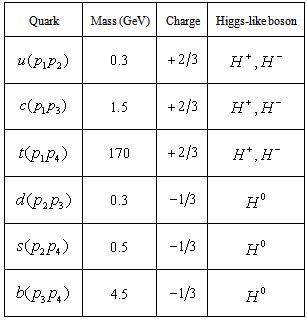 |
| |
|
With the values of  for quarks from Table 2 and making use of the Higgs-like bosons identifications in terms of the quarks we obtain Table 4 below.
for quarks from Table 2 and making use of the Higgs-like bosons identifications in terms of the quarks we obtain Table 4 below.Table 4. The quantum numbers of the Higgs-like bosons
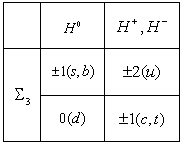 |
| |
|
According to Table 4 the neutral Higgs-like boson  is a triplet in which each member belongs to one of three possible values of
is a triplet in which each member belongs to one of three possible values of  which are
which are  . Because of this feature let us use a subscript for assigning the different values of
. Because of this feature let us use a subscript for assigning the different values of  , and thus, there are
, and thus, there are  for the Higgs-like with
for the Higgs-like with  ,
,  for the Higgs-like with
for the Higgs-like with  , and
, and  for the Higgs-like with
for the Higgs-like with  . For simplifying matters further, let us call both
. For simplifying matters further, let us call both  and
and  by
by  . This way we can say that as a proton and a neutron exchange a pion by means of a strong interaction, primons
. This way we can say that as a proton and a neutron exchange a pion by means of a strong interaction, primons  and
and  exchange a
exchange a  and form quark
and form quark  , yielding its mass, that is,
, yielding its mass, that is, .According to the above reasoning, there are the charged bosons
.According to the above reasoning, there are the charged bosons  ,
,  ,
,  ,
,  and also
and also  ,
,  ,
,  ,
,  . We can simplify the notation and designate both
. We can simplify the notation and designate both  and
and  by
by  and
and  and
and  by
by  . And for each
. And for each  we can drop the plus and minus signs and consider, for example, that the interaction of
we can drop the plus and minus signs and consider, for example, that the interaction of  and
and  by means of
by means of  produce the
produce the  quark , that is,
quark , that is, .This symbolizes
.This symbolizes  and
and which in terms of the electric charges are, respectively,
which in terms of the electric charges are, respectively, and
and and in terms of the
and in terms of the  charges are, respectively,
charges are, respectively, and
and .
.
2.1. Interactions with Equal Quarks
Let us begin with the  interactions. For example, the
interactions. For example, the  quark is the combination
quark is the combination  , and thus between two
, and thus between two  quarks there are two interactions involving
quarks there are two interactions involving  . Between two
. Between two  quarks there are two interactions by means of
quarks there are two interactions by means of  . Doing the same for the other quarks we obtain Table 5.
. Doing the same for the other quarks we obtain Table 5. Table 5. Interactions involving equal quarks
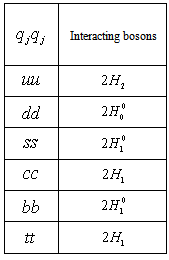 |
| |
|
2.2. Interactions between two Different Quarks
Since there are too many interactions between two different quarks, we classify them keeping one quark fixed, avoiding repetitions. For example, between quarks  and
and  there are interactions mediated by the bosons
there are interactions mediated by the bosons  and
and  . Doing the same for the other quarks we obtain Tables 6, 7, 8, 9 and 10.
. Doing the same for the other quarks we obtain Tables 6, 7, 8, 9 and 10.Table 6. Interactions involving the
 quark quark
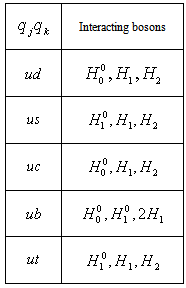 |
| |
|
Table 7. Interactions involving the
 quark, excluding quark, excluding

 |
| |
|
Table 8. Interactions involving the
 quark, excluding quark, excluding
 and and

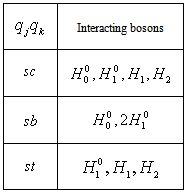 |
| |
|
Table 9. Interactions involving the
 quark, excluding quark, excluding
 , ,
 and and

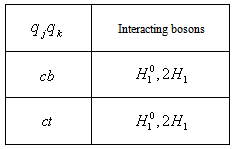 |
| |
|
Table 10. Interaction involving the
 quark, excluding quark, excluding
 and and

 |
| |
|
2.3 Most Intense Interactions with 
As we see from the above tables, the most intense interactions involving  are those of the
are those of the  quark with the
quark with the  quark and the
quark and the  quark, and the interaction of the
quark, and the interaction of the  quark with the
quark with the  quark because they are mediated by one
quark because they are mediated by one  and two
and two  . This is an important result from the experimental point of view because we can compare one of these three interactions with an interaction mediated by only one
. This is an important result from the experimental point of view because we can compare one of these three interactions with an interaction mediated by only one  . For example, comparing the interaction
. For example, comparing the interaction  with the interaction
with the interaction  , we obtain a factor of 3 for the relative strength,
, we obtain a factor of 3 for the relative strength, .And we should also have the ratios
.And we should also have the ratios .
.
2.4. Medium Intensity Interactions with 
We obtain from the above tables, that there are interactions involving two  ’s which are the interactions
’s which are the interactions  ,
,  ,
,  ,
,  ,
,  and
and  . We can compare them with those of section 2.3 and obtain the important relation (just one of the several ratios)
. We can compare them with those of section 2.3 and obtain the important relation (just one of the several ratios) .And we should also have the ratios (just some of the ratios)
.And we should also have the ratios (just some of the ratios)

2.5. Less Intense Interactions with 
From the above tables we obtain that there are interactions involving just one  which are the interactions
which are the interactions  ,
,  ,
,  ,
,  ,
,  ,
,  ,
,  ,
,  and
and  . We can compare them with those of section 2.3 and 2.4 and obtain the important relation (just some of several ratios)
. We can compare them with those of section 2.3 and 2.4 and obtain the important relation (just some of several ratios) .And we should also have the ratios (just some of the ratios)
.And we should also have the ratios (just some of the ratios)
2.6. Interactions without 
We also obtain from the above tables that there are exactly three suppressed interactions involving  which are the interactions
which are the interactions  ,
,  and
and  . This is an important prediction that can be experimentally tested.
. This is an important prediction that can be experimentally tested.
2.7. Interactions with the Charged Bosons
With respect to the charged bosons we notice that there is no interaction involving three bosons, that is, the most intense interactions involve two charged bosons. There are 15 of these interactions that are listed on Table 11. It is important to observe that there are interactions that do not involve the charged bosons. These are the six interactions  ,
,  ,
,  ,
,  ,
,  and
and  .
. Table 11. Interactions involving 2 charged bosons
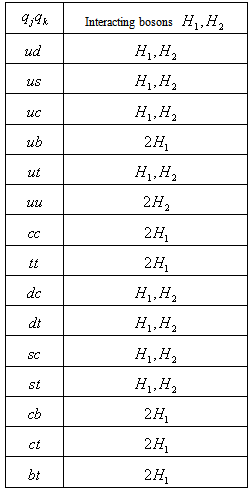 |
| |
|
3. Conclusions
All couplings of the Higgs-like bosons to quarks have been identified. With them we are able to evaluate the relative strengths of the interactions among quarks as well as the suppressed interactions. A very important result is that the search for the charged Higgs-like bosons should not involve the interactions  ,
,  ,
,  ,
,  ,
,  and
and  because they are suppressed for the charged Higgs-like bosons.
because they are suppressed for the charged Higgs-like bosons.
References
| [1] | G. Aad et al. (ATLAS Collaboration), Phys. Lett. B, vol. 716, 1, 2012. |
| [2] | G. Aad et al. (ATLAS Collaboration), Phys. Rev. D, vol 86, 032003, 2012. |
| [3] | S. Chatrchyan et al. (CMS Collaboration), Phys. Lett. B, vol. 716, 30, 2012. |
| [4] | T. Aaltonen et al. (CDF and D0 Collaborations), Phys. Rev. Lett., vol. 109, 071804, 2012. |
| [5] | T. Aaltonen et al. (CDF and D0 Collaborations), CDF note 10807, 2011. |
| [6] | V. M. Abazov et al. (D0 Collaboration), Phys. Rev. D, Vol. 84, 112005, 2011. |
| [7] | ATLAS Collaboration, ATLAS-CONF-2012-168. |
| [8] | CMS Collaboration, CMS-PAS-HIG-12-015. |
| [9] | G. Bélanger, B. Dumont, U. Ellwanger, J. F. Gunion, and S. Kraml, JHEP02 (2013) 053. |
| [10] | K. Blum, R. T. D’Angelo, and J. Fan, arXiv:1206.5303v1 {hep-ph]. |
| [11] | M. E. de Souza, “The Higgs-like Bosons and Quark compositeness”, Frontiers in Science Vol. 3(3) (2013). |

 [5,6] which is the top quark forward-backward asymmetry, and also an increase in the
[5,6] which is the top quark forward-backward asymmetry, and also an increase in the  channel[4], while the LHC has observed an excess in the diphoton channel[7,8]. Moreover, a detailed fitting to the available data up to the end of 2012[9] has shown that “In short, significant deviations from the SM values are preferred by the currently available data and should be considered viable”.Therefore, it is very important to identify the Higgs couplings to quarks to determine the true nature of the recently found Higgs-like boson. On the other hand, theoretically, only SUSY models identify the Higgs boson couplings to quarks, as discussed in the article by Blum et al.[10]. Considering the work presented in reference[11], which presented Higgs-like bosons in the framework of a composite quark model, we identify all couplings of the Higgs-like bosons to quarks.
channel[4], while the LHC has observed an excess in the diphoton channel[7,8]. Moreover, a detailed fitting to the available data up to the end of 2012[9] has shown that “In short, significant deviations from the SM values are preferred by the currently available data and should be considered viable”.Therefore, it is very important to identify the Higgs couplings to quarks to determine the true nature of the recently found Higgs-like boson. On the other hand, theoretically, only SUSY models identify the Higgs boson couplings to quarks, as discussed in the article by Blum et al.[10]. Considering the work presented in reference[11], which presented Higgs-like bosons in the framework of a composite quark model, we identify all couplings of the Higgs-like bosons to quarks.  has charge equal to +5/6 and primons
has charge equal to +5/6 and primons  have each charge equal to -1/6. Using the modified Gell-Mann and Nishijima relation
have each charge equal to -1/6. Using the modified Gell-Mann and Nishijima relation 
 , for primon
, for primon  , and
, and 
 for the other primons, we obtain,
for the other primons, we obtain,

 and
and  have isospins equal to
have isospins equal to  and
and  , respectively, we have to have
, respectively, we have to have  for primons,
for primons,  and
and  Using the modified Gell-Mann—Nishijima relation
Using the modified Gell-Mann—Nishijima relation

 , and
, and 
 and
and  assuming that
assuming that  has also
has also  . Therefore,
. Therefore,  can assume the values
can assume the values  and
and  and, thus, these values can be considered as the projections of
and, thus, these values can be considered as the projections of  (Table 1).
(Table 1). and
and  a quark has the four possible states
a quark has the four possible states  (described in detail in ref.[11]):
(described in detail in ref.[11]): Organizing the values of
Organizing the values of  and
and  for quarks on a table we obtain Table 2 below.
for quarks on a table we obtain Table 2 below. for primons from Table 1 we obtain that there should exist the Higgs-like bosons
for primons from Table 1 we obtain that there should exist the Higgs-like bosons  for generating quark masses, as shown on Table 3 below.
for generating quark masses, as shown on Table 3 below.  for quarks from Table 2 and making use of the Higgs-like bosons identifications in terms of the quarks we obtain Table 4 below.
for quarks from Table 2 and making use of the Higgs-like bosons identifications in terms of the quarks we obtain Table 4 below. is a triplet in which each member belongs to one of three possible values of
is a triplet in which each member belongs to one of three possible values of  which are
which are  . Because of this feature let us use a subscript for assigning the different values of
. Because of this feature let us use a subscript for assigning the different values of  , and thus, there are
, and thus, there are  for the Higgs-like with
for the Higgs-like with  ,
,  for the Higgs-like with
for the Higgs-like with  , and
, and  for the Higgs-like with
for the Higgs-like with  . For simplifying matters further, let us call both
. For simplifying matters further, let us call both  and
and  by
by  . This way we can say that as a proton and a neutron exchange a pion by means of a strong interaction, primons
. This way we can say that as a proton and a neutron exchange a pion by means of a strong interaction, primons  and
and  exchange a
exchange a  and form quark
and form quark  , yielding its mass, that is,
, yielding its mass, that is, .According to the above reasoning, there are the charged bosons
.According to the above reasoning, there are the charged bosons  ,
,  ,
,  ,
,  and also
and also  ,
,  ,
,  ,
,  . We can simplify the notation and designate both
. We can simplify the notation and designate both  and
and  by
by  and
and  and
and  by
by  . And for each
. And for each  we can drop the plus and minus signs and consider, for example, that the interaction of
we can drop the plus and minus signs and consider, for example, that the interaction of  and
and  by means of
by means of  produce the
produce the  quark , that is,
quark , that is, .This symbolizes
.This symbolizes  and
and which in terms of the electric charges are, respectively,
which in terms of the electric charges are, respectively, and
and and in terms of the
and in terms of the  charges are, respectively,
charges are, respectively, and
and .
. interactions. For example, the
interactions. For example, the  quark is the combination
quark is the combination  , and thus between two
, and thus between two  quarks there are two interactions involving
quarks there are two interactions involving  . Between two
. Between two  quarks there are two interactions by means of
quarks there are two interactions by means of  . Doing the same for the other quarks we obtain Table 5.
. Doing the same for the other quarks we obtain Table 5.  and
and  there are interactions mediated by the bosons
there are interactions mediated by the bosons  and
and  . Doing the same for the other quarks we obtain Tables 6, 7, 8, 9 and 10.
. Doing the same for the other quarks we obtain Tables 6, 7, 8, 9 and 10.
 are those of the
are those of the  quark with the
quark with the  quark and the
quark and the  quark, and the interaction of the
quark, and the interaction of the  quark with the
quark with the  quark because they are mediated by one
quark because they are mediated by one  and two
and two  . This is an important result from the experimental point of view because we can compare one of these three interactions with an interaction mediated by only one
. This is an important result from the experimental point of view because we can compare one of these three interactions with an interaction mediated by only one  . For example, comparing the interaction
. For example, comparing the interaction  with the interaction
with the interaction  , we obtain a factor of 3 for the relative strength,
, we obtain a factor of 3 for the relative strength, .And we should also have the ratios
.And we should also have the ratios .
.
 ’s which are the interactions
’s which are the interactions  ,
,  ,
,  ,
,  ,
,  and
and  . We can compare them with those of section 2.3 and obtain the important relation (just one of the several ratios)
. We can compare them with those of section 2.3 and obtain the important relation (just one of the several ratios) .And we should also have the ratios (just some of the ratios)
.And we should also have the ratios (just some of the ratios)


 which are the interactions
which are the interactions  ,
,  ,
,  ,
,  ,
,  ,
,  ,
,  ,
,  and
and  . We can compare them with those of section 2.3 and 2.4 and obtain the important relation (just some of several ratios)
. We can compare them with those of section 2.3 and 2.4 and obtain the important relation (just some of several ratios) .And we should also have the ratios (just some of the ratios)
.And we should also have the ratios (just some of the ratios)

 which are the interactions
which are the interactions  ,
,  and
and  . This is an important prediction that can be experimentally tested.
. This is an important prediction that can be experimentally tested. ,
,  ,
,  ,
,  ,
,  and
and  .
.  ,
,  ,
,  ,
,  ,
,  and
and  because they are suppressed for the charged Higgs-like bosons.
because they are suppressed for the charged Higgs-like bosons. Abstract
Abstract Reference
Reference Full-Text PDF
Full-Text PDF Full-text HTML
Full-text HTML

 and
and  for quarks
for quarks



 quark
quark
 quark, excluding
quark, excluding 

 quark, excluding
quark, excluding  and
and 

 quark, excluding
quark, excluding  ,
,  and
and 

 quark, excluding
quark, excluding  and
and 

